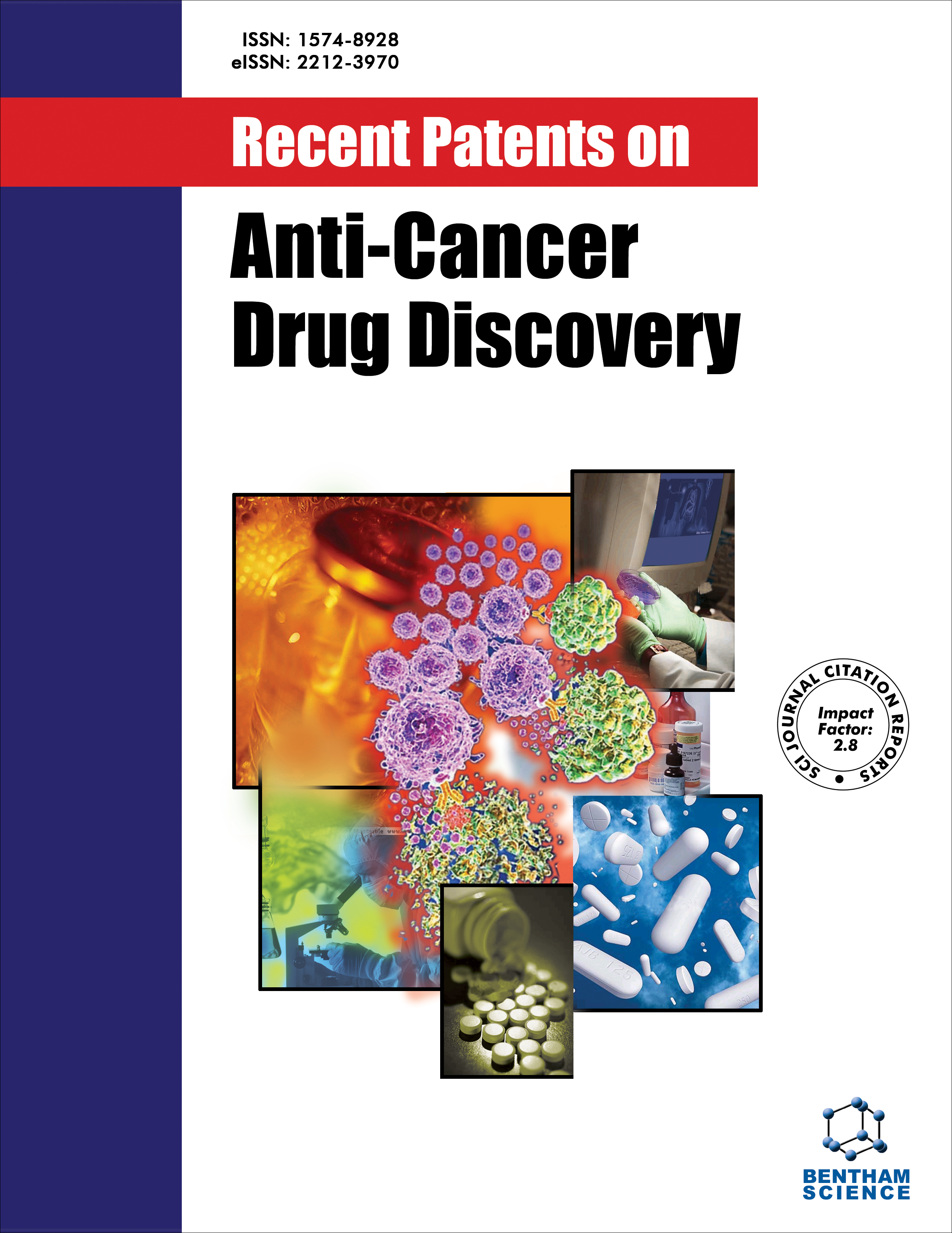- Home
- A-Z Publications
- Recent Patents on Anti-Cancer Drug Discovery
- Previous Issues
- Volume 18, Issue 4, 2023
Recent Patents on Anti-Cancer Drug Discovery - Volume 18, Issue 4, 2023
Volume 18, Issue 4, 2023
-
-
Research and Patents Status of Selected Phytochemicals Against Cancer: How Close and How Far?
More LessAuthors: Homa Fatma and Hifzur R SiddiqueBackground: Cancer is a global health issue and economic burden with a continuous increase in incidence and mortality. Over the years, the underlying molecular mechanism of cancers was thoroughly researched, leading to multiple drugs' development. Unfortunately, most drugs have some serious drawbacks, such as therapy resistance and toxicity. Epidemiological studies have shown that a diet rich in fruits and veget Read More
-
-
-
Gefitinib: An Updated Review of its Role in the Cancer Management, its Nanotechnological Interventions, Recent Patents and Clinical Trials
More LessAuthors: Pankaj Kumar, Bharti Mangla, Shamama Javed, Waquar Ahsan, Pankaj Musyuni, Aarif Ahsan and Geeta AggarwalBackground: Gefitinib, a tyrosine kinase inhibitor, is effectively used in the targeted treatment of malignant conditions. It suppresses the signal transduction cascades leading to cell proliferation in the tumors and is now currently approved in several countries globally as secondline and third-line treatment for non-small cell lung cancer (NSCLC). Objective: This review is aimed to summarize the journey of gefitinib as an establi Read More
-
-
-
Prospective Challenges for Patenting and Clinical Trials of Anticancer Compounds from Natural Products: Coherent Review
More LessAuthors: Ankit Sahoo, Ashok K. Mandal, Mayank Kumar, Khusbu Dwivedi and Deepika SinghCancer is a leading cause of morbidity and mortality worldwide. Each year, millions of people worldwide are diagnosed with cancer, and more than half of them die. Various conventional therapies for cancer, including chemotherapy and radiotherapy, have extreme side effects. Therefore, to minimize the global burden of lethal diseases like cancer, an effective and novel drug must be discovered. Its patent should be acquired Read More
-
-
-
The Patent Landscape of BRAF Target and KRAS Target
More LessAuthors: Hai-Long Zhang and Yongxia LiBackground: KRAS and BRAF targets are involved in the epidermal growth factor receptor pathway. KRAS and BRAF targets are the most frequent driver mutations in cancer. Objective: The objective of the study was to present the recent developments in the KRAS target and the BRAF target. Methods: KRAS target and BRAF target were analyzed by US patent analysis. All US granted patent documents from January 2002 to Nov Read More
-
-
-
Understanding and Targeting the Epigenetic Regulation to Overcome EGFR-TKIs Resistance in Human Cancer
More LessAuthors: Lan Sun, Lingyue Gao, Yingxi Zhao, Yuqing Wang, Qianhui Xu, Yiru Zheng, Jiali Chen, He Wang and Lihui WangBackground: The occurrence and progression of cancer are the results of the dysregulation of genetics and epigenetics. Epigenetic regulation can reversibly affect gene transcription activity without changing DNA structure. Covalent modification of histones is crucial in the epigenetic regulation of gene expression. Furthermore, epidermal growth factor receptor (EGFR) significantly affects cell tumorigenesis, proliferation, antitum Read More
-
-
-
LncRNA TCTN2 Promotes the Malignant Development of Hepatocellular Carcinoma via Regulating mIR-1285-3p/ARF6 Axis
More LessAuthors: Qian Liu, Chunfu Zhu and Yanfen DongBackground: Hepatocellular carcinoma (HCC) is one of the most life-threatening malignant diseases. TCTN2 protein participates in tumorigenesis and development. However, whether lncRNA TCTN2 is associated with HCC pathogenesis remains unclear. Methods: The expression of lncRNA, TCTN2, miR-1285-3p, and ARF6 in HCC tissues and cells was detected by a quantitative Real-Time PCR (qRT-PCR) assay. lncRNA TCTN2-s Read More
-
-
-
s The Efficacy and Safety of Anlotinib Alone and in Combination with Other Drugs in Previously Treated Advanced Thymic Epithelia Tumors: A Retrospective Analysis
More LessAuthors: Shuo Li, Haiyan Zhou, Xiqin Zhang, Bing Bu, Rongjie Tao, Hui Zhang and Jinming YuBackground: Thymic epithelial tumors (TETs) are rare thoracic malignancies with no standard second-line treatment. Tumor angiogenesis is closely associated with the pathogenesis and invasiveness of TETs. Anlotinib is a small-molecule multitarget tyrosine kinase inhibitor (TKI) which inhibits tumor angiogenesis and tumor cell proliferation. Published studies have demonstrated the promising clinical effect of multitarget TKIs su Read More
-
-
-
Gene Expression Network and Circ_0008012 Promote Progression in MLL/AF4 Positive Acute Lymphoblastic Leukemia
More LessBackground: Acute lymphoblastic leukemia with MLL/AF4 rearrangement remains a major hurdle to improving outcomes. Gene network and circRNAs have been found to participate in tumorigenesis, while their roles in leukemia still need to be explored. Recent patents have shown that circRNAs exhibit the markers for the children ALL, although the target and related mechanism remain to be elucidated. Objective: This s Read More
-
-
-
s Novel 4-chloro-N-phenyl Benzamide Derivatives as p38α Mitogenactivated Protein Kinase Inhibitors for Treating Cancer, COVID-19, and Other Diseases
More LessBy Surya K. DeThe present disclosure relates to p38α mitogen-activated protein kinase inhibitors, pharmaceutical compositions thereof, and the use of the p38α mitogen-activated protein kinase inhibitors and pharmaceutical compositions thereof for treating various diseases such as cancer, rheumatoid arthritis, amyotrophic lateral sclerosis, cystic fibrosis, cardiovascular disease, multiple sclerosis, inflammatory bowel disease, chronic ob Read More
-
Volumes & issues
-
Volume 20 (2025)
-
Volume 19 (2024)
-
Volume 18 (2023)
-
Volume 17 (2022)
-
Volume 16 (2021)
-
Volume 15 (2020)
-
Volume 14 (2019)
-
Volume 13 (2018)
-
Volume 12 (2017)
-
Volume 11 (2016)
-
Volume 10 (2015)
-
Volume 9 (2014)
-
Volume 8 (2013)
-
Volume 7 (2012)
-
Volume 6 (2011)
-
Volume 5 (2010)
-
Volume 4 (2009)
-
Volume 3 (2008)
-
Volume 2 (2007)
-
Volume 1 (2006)
Most Read This Month
Article
content/journals/pra
Journal
10
5
false
en


